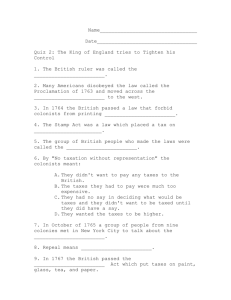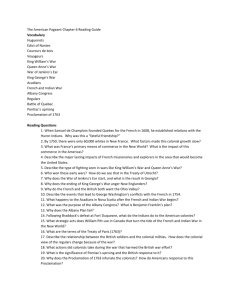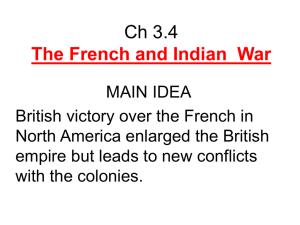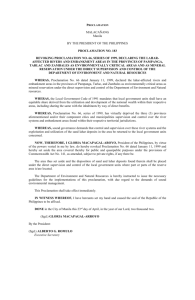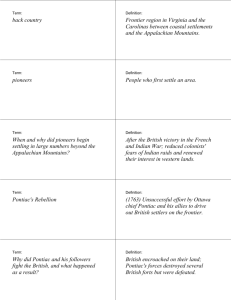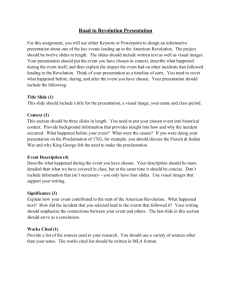View/Open - oURspace
advertisement
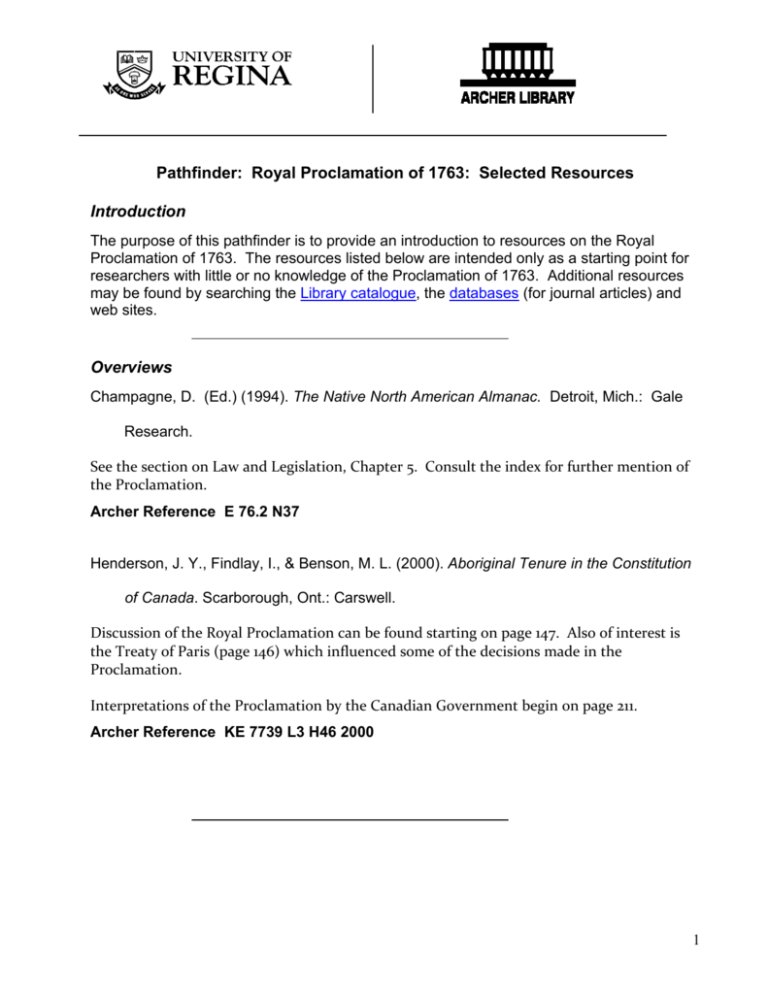
Pathfinder: Royal Proclamation of 1763: Selected Resources Introduction The purpose of this pathfinder is to provide an introduction to resources on the Royal Proclamation of 1763. The resources listed below are intended only as a starting point for researchers with little or no knowledge of the Proclamation of 1763. Additional resources may be found by searching the Library catalogue, the databases (for journal articles) and web sites. Overviews Champagne, D. (Ed.) (1994). The Native North American Almanac. Detroit, Mich.: Gale Research. See the section on Law and Legislation, Chapter 5. Consult the index for further mention of the Proclamation. Archer Reference E 76.2 N37 Henderson, J. Y., Findlay, I., & Benson, M. L. (2000). Aboriginal Tenure in the Constitution of Canada. Scarborough, Ont.: Carswell. Discussion of the Royal Proclamation can be found starting on page 147. Also of interest is the Treaty of Paris (page 146) which influenced some of the decisions made in the Proclamation. Interpretations of the Proclamation by the Canadian Government begin on page 211. Archer Reference KE 7739 L3 H46 2000 1 Primary Sources Great Britain. Parliament. (1824). A collection of the acts passed in the Parliament of Great Britain and of other public acts relative to Canada. Quebec: P.E. Desbarats. Retrieved January 6, 2009 from http://www.canadiana.org/view/42695/0030 The full text of the Royal Proclamation of 1763 can be found in this online resource beginning on page 26. Smith, D. G. (Ed.). (1975). Canadian Indians and the Law: Selected Documents, 1663 1972. Toronto: McClelland and Stewart. Be sure to read the introduction. It helps to set all these documents into proper historical context. The book includes the Royal Proclamation 1763, Instructions to Governor Murray, The BNA Act, and others. ARCHER: KE 7703.5 1975 Secondary Sources Borrows, J. (1997). Wampum at Niagara: the Royal Proclamation, Canadian legal history, and self government. In Asch, M. (Ed.), Aboriginal and treaty rights in Canada : essays on law, equality, and respect for difference. (pp.155-172). Vancouver: UBC Press. This chapter provides historical background on the Royal Proclamation, as well as interpretation of the document. There is emphasis on the importance of reading the Royal Proclamation together with the Treaty of Niagara. Archer E 92 A23 1997 FNUNIV E 92 A23 1997 Calloway, C. G. (2006). The scratch of a pen : 1763 and the transformation of North America. New York: Oxford University Press. 2 The first part of the book provides background information on the events leading up to the Royal Proclamation and the state of affairs between North American Indians and Europeans. Chapter 4 begins the discussion of the Proclamation of 1763, outlining the reasons behind the Proclamation, interpretations of the document and the subsequent fallout. Consult the index for further references to the Royal Proclamation. Internet Ebook Campion E 46 C34 2006 FNUNIV E 46 C34 2006 Canada. Royal Commission on Aboriginal Peoples [RCAP]. (1996). Report. Volume 1, Part one, Chapter 5: Stage two: Contact & Cooperation: the Royal Proclamation of 1763. [Ottawa]: Minister of Supply and Services. Retrieved January 19, 2009, from http://www.ainc-inac.gc.ca/ap/pubs/sg/cg/cg5-eng.pdf This section analyzes the history and meaning of the Proclamation. The complete text of the Royal Proclamation is included in Appendix D of the Report on p. 720. See also Chapter 9, pages 259‐263 for a discussion of the Proclamation in the context of Sovereignty and the Indian Act. Archer E 92 C2447 1996 v. 1-5 Archer Government Publications CA1..Z…. 1 91A15 v. 1-2, 4-5 Foster, H. (1999). ‘Indian Administration’ from the Royal Proclamation of 1763 to Constitutionally Entrenched Aboriginal Rights”. In Havemann, P. (Ed.), Indigenous Peoples' Rights in Australia, Canada, and New Zealand (pp. 351-577). Aukland: Oxford University Press. This chapter summarizes the history of Indian governance in Canada from the Royal Proclamation to the amendment of the Constitution in 1982. Archer K 3247 I525 1999 Jacobs, W. R. (1985). Dispossessing the American Indian : Indians and whites on the colonial frontier. Norman: University of Oklahoma Press. 3 See in particular Chapter 9, page 95: “1763 – Year of Decision on the Indian Frontier.” Of note is the map of the demarcation line set out by the Proclamation on pages 98‐99. Archer E 91 J3 1985 FNUNIV E 91 J3 1985 Macklem, P. (2001). Indigenous difference and the Constitution of Canada. Toronto: University of Toronto Press. This book provides a comprehensive look at Aboriginal rights within the context of the Canadian constitution. Archer E 92 M325 2000 FNUNIV E 92 M325 2000 Mandell, L. (1984). The Union of British Columbia Indian Chiefs Fights Patriation. In Martin, R. (Ed.), Critical perspectives on the Constitution (pp 164-195). Winnipeg: Society for Socialist Studies. This chapter discusses the opposition of Indian Nations to the patriation of the constitution with reference to historical agreements with the British Crown, including the Royal Proclamation of 1763. Archer HX 1 S652 no. 2 Slattery, B. (1983). Ancestral lands, alien laws: Judicial perspectives on aboriginal title. Saskatoon: Native Law Centre, University of Saskatchewan. This short study provides specific examples of land claims cases and how the Royal Proclamation influenced the rulings. Archer E 98 L3 S43 FNUNIV E 98 L3 S43 Need Help? Archer Library Information Desk. Visit us: main floor of Archer Library Voice: (306) 585 - 4134/4495. MSN: ask.archer@uregina.ca (details: www.uregina.ca/library/contactIM.shtml) E-mail: ask.archer@uregina.ca 4 SF/JR 09

